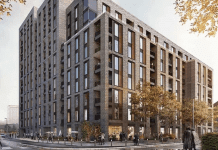In an interview with Paul Griffiths, Head of BIM Strategy and Development at Ordnance Survey, he explains how geospatial data, the Smart City and BIM will help solve our urban challenges…
The opportunity to address the complex nature of city life and its management with innovative solutions and digital technologies is here, now. It is possible to use our knowledge to not only address the challenges directly, but also work to create better cities for a predicted surge in urban living (current projections suggest that 70% of people globally will live in cities by 2050).
The pressures arising from the predicted surge will create many challenges for decision-makers around the world and cities are going to need infrastructure to support that growth. The successful smart city will be one in which all the stakeholders are working together to identify tomorrow’s social and economic trends, anticipate service needs and install the enabling, low-carbon technology today.
Ordnance Survey are working on the solutions to create our smart cities utilising BIM, and this interview with Paul Griffiths is intended to give a brief overview of where we are now.
What does the term Smart City mean to you?
At the highest level, the ‘Smart City’ approach is about addressing a whole range of significant, persistent urban challenges. For example, over-crowding, transport and energy in an integrated and connected way. A successful smart city involves all stakeholders working together to identify tomorrow’s social and economic trends, anticipate service needs and install the enabling, low-carbon technology today.
How will geospatial data benefit the future urban landscape, and how are Ordnance Survey (OS) driving this forward?
Location, in all its senses (where people and vehicles are, where they are going and how quickly, where bottlenecks are forming, which amenities are nearby), is key to the success of smart cities. Construction, infrastructure, physical assets, and transactions all exist and occur somewhere, and there is real value in connecting all the associated data to a common geospatial framework, in particular by using persistent shared identifiers. This can dramatically improve the way in which different systems talk to each other. A recent report from McKinsey suggests that around 40% of the future value of smart city infrastructure lies in improved connectivity and cross-referencing – and this is the key difference that geospatial data can provide.
We at OS are investing heavily in the BIM and smart city future in three ways. Firstly, we are working to improve our data content to ensure that it is more current, replicates the real world even more closely (for example by increasing the 3D component) and is enriched with links to other authoritative data. Secondly, we’re providing new ways to interact with our data, with a whole suite of new API services that allow information to be exchanged through online transactions and queries. Thirdly, we’re actively working with a number of projects to help define and realise BIM and smart city futures.
What are the challenges around data collection, and are we smart enough to understand and use data effectively?
Survey4BIM is a cross-industry group supported by the UK Government BIM Task Group. It is made up of organisations involved in the survey, collection, management, processing and delivery of geospatial information within a BIM environment. It is open to all and its mission is “to provide a forum for survey organisations and industry professionals to collaborate and share their journey putting ‘BIM into practice’, and to provide best practice guidance documents on survey matters relating to BIM”. Survey4BIM has identified five of the key geospatial challenges for the profession as being:
- Level of detail required;
- Interoperability;
- Meta-data;
- Accuracy and Generalisation.
To tackle them, to enable BIM to be successful as well as to create the opportunities available for the survey industry, the professionals are working together.
What is the relationship between BIM and geospatial data?
Geospatial data and Unique Identifiers (TOID/UPRN) are a critical requirement to understand and manage relationships across physical assets (buildings and infrastructure), the real world environment, people and process. A physical asset represented within a BIM model operates in total isolation of the world around it. There is a need to understand the context the feature operates within, therefore a common operating picture using geospatial data to bring the information together is required. This supports professional’s decision making processes and derives significant improvements in costs, waste, value and sustainability.
Is geotechnical BIM widely recognised as a benefit?
It is widely recognised that geospatially located sub-surface information will benefit the BIM process. Management of the sub-surface is an area of increasing concern as the costs of ad hoc management are beginning to be seen in terms of ‘blocked’ (tunnel) corridors, impacts from above surface to buried assets, access issues to buried assets, etc. To date, work on managing these issues has been addressed by simple ‘coincidence’ mapping (i.e. above/below ground structures have been aligned geospatially rather than integrated within a unified data model).
We are looking to create explicit links between sub surface and geospatial data.
Paul Griffiths
Head of BIM Strategy and Development
Ordnance Survey Limited
Tel: 03456 050505
www.twitter.com/OrdnanceSurvey













